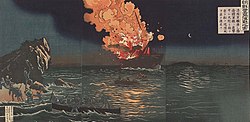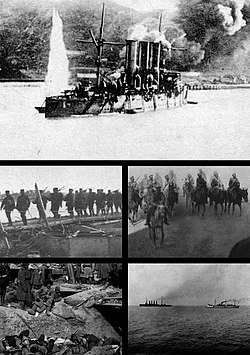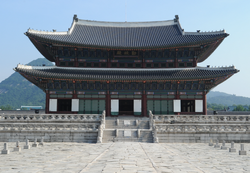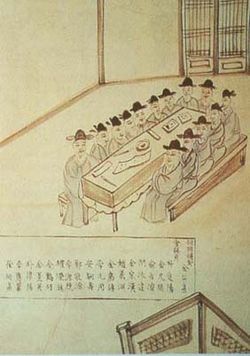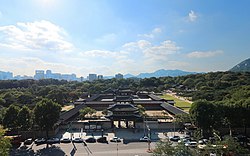The Japanese occupation of Gyeongbokgung Palace (Korean: 일본군의 경복궁 점령) or the Gabo Incident occurred on 23 July 1894, during the ceasefire of the Donghak...
20 KB (2,312 words) - 17:49, 15 March 2025
Japanese occupation of Guam Japanese occupation of Gyeongbokgung Japanese occupation of Hong Kong Japanese occupation of Istanbul Japanese occupation of Southern...
3 KB (380 words) - 13:06, 26 January 2025
to Japan, and hundreds of historic buildings like the Gyeongbokgung and Deoksugung palaces were either partially or completely demolished. Japan also...
189 KB (19,787 words) - 15:50, 15 April 2025
1905–1945 Chōsen – 1910–1945 Japanese occupation of Gyeongbokgung 1894 Occupation of Peking 1900 Nan’yō 1919–1945 Japanese Occupation of Tsingtao All ports and...
12 KB (640 words) - 23:13, 15 April 2025
Hong Kyehun (category Military history of Korea)
First Sino-Japanese War Joseon Army (late 19th century) Emperor Gojong Empress Myeongseong Imo Incident Japanese occupation of Gyeongbokgung Palace Eulmi...
21 KB (2,404 words) - 06:21, 3 April 2025
Japanese invasions of Korea may refer to: Japanese invasions of Korea (1592–1598) Donghak Peasant Revolution Japanese occupation of Gyeongbokgung Russo-Japanese...
213 bytes (57 words) - 18:59, 16 December 2024
Empress Myeongseong (redirect from Queen Min of Joseon)
Joseon dynasty Political factions during the Joseon dynasty Japanese Occupation of Gyeongbokgung Palace Joseon Dynasty Current location: 250-1 Neunghyeon-dong...
107 KB (13,848 words) - 23:48, 7 March 2025
seized the Korean emperor, and set up a pro-Japanese government on 23 July 1894 in the occupation of Gyeongbokgung. The Qing government decided to withdraw...
128 KB (16,984 words) - 05:03, 17 April 2025
leader of the anti-Japanese and pro-Chinese faction at the Korean court was murdered by Japanese agents within the halls of the Gyeongbokgung palace, an act...
174 KB (21,375 words) - 09:30, 18 April 2025
Imjin War (redirect from Japanese invasions of Korea (1592–1598))
the context of Japanese imperialism, the invasions are seen as the first Japanese attempt to become a global power. The partial occupation of Korea developed...
234 KB (31,425 words) - 17:15, 13 April 2025
Occupation of Seoul may refer to: The 1894 Japanese Occupation of Gyeongbokgung Palace, part of the First Sino-Japanese War The North Korean occupation...
399 bytes (91 words) - 17:48, 19 May 2022
over Japanese alteration and destruction of various Korean monuments including Gyeongbokgung and the revision of documents that portrayed the Japanese in...
30 KB (3,235 words) - 08:16, 3 April 2025
part in the slaying. Japanese occupation of Gyeongbokgung Death of Gojong of Korea [ko]: Theories that Gojong was poisoned by Japanese agents in 1919. Korean: 을미사변;...
63 KB (7,575 words) - 22:05, 16 April 2025
Building was constructed by the Empire of Japan on the site of the Gyeongbokgung complex, the royal palace of the Joseon, and was the largest government...
14 KB (1,502 words) - 06:58, 14 February 2025
Changdeokgung (category Palaces of Joseon)
invaders entered the city on the 2nd day, 5th month of that year, Gyeongbokgung was still in tact. Japanese discipline in the city was reportedly initially...
89 KB (5,196 words) - 11:48, 9 April 2025
Pak Yŏnghyo (category Korean collaborators with Imperial Japan)
flee to Japan, where he initially stayed with Fukuzawa Yukichi, before moving on to Kobe. Following the Japanese Occupation of Gyeongbokgung Palace, Pak...
11 KB (1,103 words) - 05:17, 4 March 2025
Blue House (redirect from Pavilion of Blue Tiles)
the neighboring Empire of Japan's annexation of Korea in 1910, the Imperial Japanese governor of Korea used the Gyeongbokgung grounds for the Government-General...
65 KB (7,766 words) - 22:21, 11 April 2025
to provoke a war between Qing and Japan. As a result of the illegal occupation of Gyeongbokgung Palace by the Japanese army, the Donghak Peasant Army's...
27 KB (3,494 words) - 01:58, 15 March 2025
of Korea (Korean: 국립민속박물관) is a national museum located on the grounds of Gyeongbokgung in Jongno District, Seoul, South Korea. It uses replicas of historical...
7 KB (576 words) - 11:55, 16 March 2025
(1969). "A Brief Documentary Survey of Japanese Pirate Activities in Korea in the 13 th—15 th Centuries". Journal of Korean Studies (1969-1971). 1 (1):...
23 KB (226 words) - 11:25, 18 January 2025
Korean independence movement (redirect from Anti-Japanese struggle)
of the Japanese occupation in 1945. Following Joseon's forced opening, Japan continued to open more and more parts of Korea to exclusive Japanese trade...
28 KB (3,276 words) - 14:32, 4 March 2025
Comfort women (redirect from Japanese Military Sexual Slavery)
Japanese Armed Forces in occupied countries and territories before and during World War II. The term comfort women is a translation of the Japanese ianfu...
263 KB (26,829 words) - 15:11, 18 April 2025
Seoul (redirect from Five Grand Palaces of Joseon-Dynasty Seoul)
of Korea has a collection of 220,000 artifacts. The National Folk Museum is located on the grounds of Gyeongbokgung and focuses on the daily life of historical...
122 KB (10,732 words) - 12:44, 18 April 2025
Gyeonghuigung (category History of Seoul)
part of the palace for construction materials to rebuild Gyeongbokgung. The Japanese dismantled what remained of the palace during their occupation of the...
7 KB (677 words) - 14:04, 3 April 2025
themselves be the ancestors of the Japanese people. The Japanese word "Zainichi" itself means a foreign citizen "staying in Japan", and implies temporary...
93 KB (10,233 words) - 08:00, 3 April 2025
Kabo Reform (category Articles containing Japanese-language text)
employee of the Korean king, a group of Japanese agents entered Gyeongbokgung, killed Queen Min and desecrated her body in the north wing of the palace...
25 KB (3,008 words) - 15:47, 3 April 2025
Bank of Chōsen (Japanese: 朝鮮銀行, romanized: Chōsen Ginkō, Korean: 조선은행 Joseon Eunhaeng), known from 1909 to 1911 as the Bank of Korea (Japanese: 韓國銀行...
19 KB (2,383 words) - 23:11, 18 February 2025
positions of wealth and power to lead lives of study and integrity. Taejo moved the capital to Hanyang (modern-day Seoul) and built the palace Gyeongbokgung. In...
156 KB (17,582 words) - 17:11, 11 April 2025
Joseon Dynasty, the Japanese were joined by rebelling Korean slaves, who burned down the palace of Gyeongbokgung and its storehouse of slave records. Local...
48 KB (6,909 words) - 23:29, 28 February 2025
Changgyeonggung (category Buildings and structures of Korea under Japanese rule)
the palaces in Seoul. It is smaller than the two-story main halls of Gyeongbokgung and Changdeokgung because it was originally built as the queen's living...
11 KB (1,144 words) - 02:54, 3 April 2025





